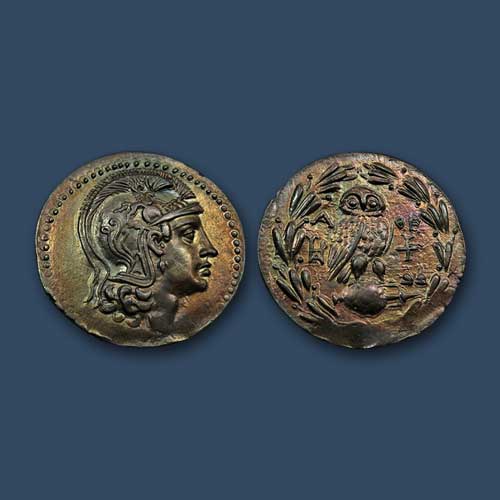Enhanced New Style Athens Tetradrachm Creates an Impression
2017-11-09 Thu
No one could match the power and independent nature of Athens, but ultimately its invincibility was put to rest. It was conquered first by Sparta, then by Macedonia, and eventually by Rome. Everyone was aware of Athens’ value and it was allowed to remain a wealthy city and cradle of culture, but was no longer a discrete power, except for the Tetradrachm.For over three centuries, the previous Owl tetradrachms were the dominant international trade coinage, but as Athens changed hands, their coinage eventually changed as well, moving away from the archaic coins into a newly stylized tetradrachm which carried over artistic elements from its predecessor.
After Athens’ economic condition improved as it recovered from the port of Delos in 166 BCE, they started producing new coins on a wider scale. The new coinage didn’t become quite as ubiquitous as the early tetradrachms, but they have been found throughout the Mediterranean and certainly circulated internationally.
Rome dominated Greece and confiscated land and destroyed many cities, but Athens was free as the Romans were swayed by its intellectual, cultural and artistic value. The mintage of the “new style” tetradrachms began in 164 BCE and continued on an annual basis up until Sulla’s capture of Athens in 86 BCE, after which the coins were produced far less frequently until ultimately stopping around 40 BCE.
The new coinage paid respect to the earlier tetradrachms by carrying over the iconography of an obverse, depicting Athena and a reverse featuring her owl. But, the fabric of the coin was had gone through many changes, thinning and broadening to a much wider diameter.
The artists were excited as they got a larger space to engrave more intricate designs. Athena is depicted with a triple-crested Attic helmet upon which the foreparts of a quadriga of horses are shown beneath a full flying Pegasus.
The reverse now shows an owl standing on an amphora, a jug referring to Athens’ international olive oil trade, surrounded by an olive wreath in which various symbols and names are included to denote the mintage and origination of the emission. The first line of reverse text retains the archaic “AOE” denoting that the coins are “of the Athenians”.
Athens remained a center of great influence during its 500 years under Roman rule with many emperors supporting it financially and politically. Unfortunately, much of Athens was destroyed after being sacked by the Germanic “Heruli” tribe in 267 CE, and this marked the end of Athens’ reign as one of the history’s most influential societies.
Latest News
-
Panchala King Bhanumitra Copper Coin
2024-04-26 FriThe Panchala kingdom was ruled by the Mitra kings. The Mitra kings are known to issue coins and most...
-
Mahatma
2024-04-25 ThuIndia Post issued a commemorative postage stamp on #LalaHansraj, also known as Mahatma Hansraj for�...
-
Berar Mint of Muhammad Akbar
2024-04-25 ThuBerar was a kingdom located in the Deccan region, with Elichpur as its capital. It was one of the Su...
-
Janma Kalnayak of Bhagwan Mahavir
2024-04-24 WedOn 21st April 2024 which was the 2550th Janma Kalnyanak of Bhagwan Mahavir Swami, PM Modi unveile...
-
Gold Pagoda of Vijaynagar Empire King Deva Raya I
2024-04-10 WedKing Deva Raya I of the Vijayanagara Empire was a patron of Kannada literature and architecture. He ...

